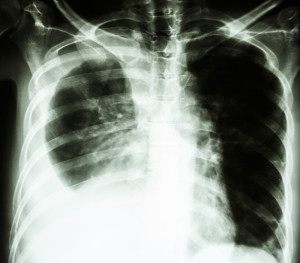Introduction
I discuss pleural disease in this chapter. The pleura is the membrane that envelopes the lungs. The pleural cells produce a small amount of slippery pleural fluid, which keeps the lung surface moist and slippery. This allows for smooth movements of the lungs against the pleural lining of the chest wall with every breath we take. Normally this is entirely pain free.
Difficulties breathing
Most people are not aware of breathing. However, there are many conditions where this is not so. When there is an inflammation of the pleura (= pleuritis) from an infection or from trauma, there can be scarring and the two opposing layers of pleura can stick together or rub on the scar tissue area. This can cause pain. It can also cause fluid production and such an accumulation of fluid in the chest cavity has the name “pleural effusion”.
This condition is often associated with childhood tuberculosis, with fungal lung infections, pulmonary embolism or a malignant mesothelioma due to asbestosis etc.
Signs and Symptoms
A pleural effusion is not always symptomatic in the beginning, but when it causes shortness of breath due to an inability of the lungs to expand, it leads to shortness of breath and pressure with breathing.
Symptoms vary according to underlying diseases
If there is a lot of inflammation due to mechanism of the underlying disease process, there can be pain with every breath the patient takes. As the link above shows, there can be a myriad of clinical conditions that can cause a pleural effusion from congestive heart failure to rheumatic illnesses (lupus, rheumatoid disease), from mesothelioma and asbestosis to Hodgkin’s lymphoma and metastases to the pleural cavity from other cancers. This list is incomplete. However, it shows that the underlying disease process, of which a pleural effusion is only a part of, will determine the other symptoms. The treating physician must have an investigative mind and order appropriate tests. Often it takes a referral of the patient to a lung specialist who will arrange the tests to come to the right diagnosis.
Diagnostic Tests
There are a number of diagnostic tests for pleural disease, which help the physician to narrow in the diagnostic possibilities. Chest X-rays and CT scan usually can identify a pleural effusion. Further tests such as ultrasound investigations distinguish between solid or liquid phases and show whether or not the effusion ha a division into several chambers (loculated). With thoracentesis a needle is introduced into the pleural space where the bulk of the effusion is; the physician can do this accurately with ultrasound guidance to place the needle exactly into the center of the bulk of the pleural fluid. At the end of this procedure the physician sends the pleural fluid to the laboratory. The pathologist performs various tests with the material including a chemical analysis and cell analysis. A thoracoscopic pleural biopsy is the most direct approach to get a small, but typical biopsy sample for histological analysis of mesothelioma.
Treatment
The treatment will depend on the cause of the pleural disease. The principles outlined here are identical for adult patients and children as well. Asbestosis related disease can be managed, but not necessarily be cured. Here is a site that deals with asbestos related disease. Malignant mesothelioma associated with asbestos exposure is a difficult to treat malignancy. Infections such as pneumonia are treated with antibiotics. Tuberculosis or fungal infections are treated with the appropriate combinations of antituberculous or antifungal antibiotics. SLE (=lupus) and rheumatoid disease is treated by the rheumatologist and the combination therapy may have to be stepped up to get the disease process under control. Congestive heart failure is being treated by the cardiologist depending on the underlying cause.
References
1. Noble: Textbook of Primary Care Medicine, 3rd ed., Copyright © 2001 Mosby, Inc.
2. National Asthma Education and Prevention Program. Expert Panel Report II. National Heart, Lung and Blood Institute, 1997.
3. Rakel: Conn’s Current Therapy 2002, 54th ed., Copyright © 2002 W. B. Saunders Company
4. Murray & Nadel: Textbook of Respiratory Medicine, 3rd ed., Copyright © 2000 W. B. Saunders Company
5. Behrman: Nelson Textbook of Pediatrics, 16th ed., Copyright © 2000 W. B. Saunders Company
6. Merck Manual: Environmental lung diseases (thanks to www.merckmanuals.com for this link)
7. Goldman: Cecil Textbook of Medicine, 21st ed., Copyright © 2000 W. B. Saunders Company
8. Ferri: Ferri’s Clinical Advisor: Instant Diagnosis and Treatment, 2004 ed., Copyright © 2004 Mosby, Inc.
9. Rakel: Conn’s Current Therapy 2004, 56th ed., Copyright © 2004 Elsevier
10. Suzanne Somers: “Breakthrough” Eight Steps to Wellness– Life-altering Secrets from Today’s Cutting-edge Doctors”, Crown Publishers, 2008







